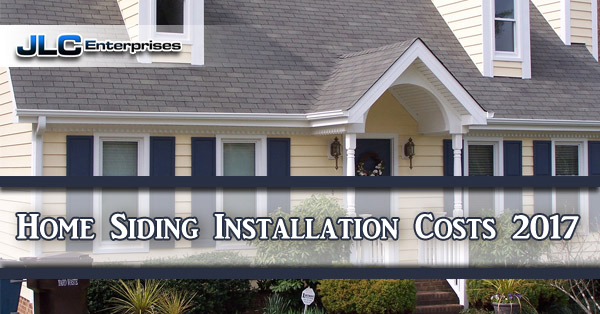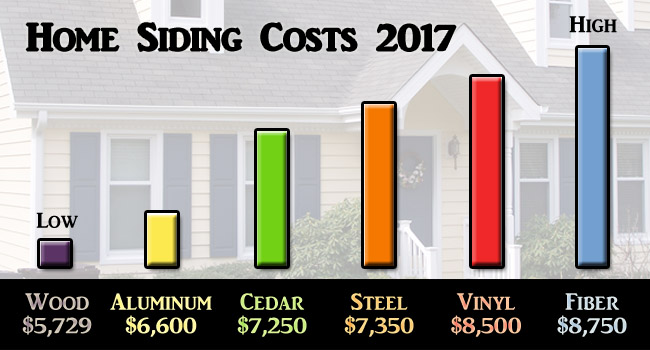
Looking for home siding costs in 2017? We have all the different types of siding listed from lowest to highest cost. Are you looking to make a dramatic yet quick change to the appearance of your home? Then just change the siding. There is a dependability that vinyl siding is low maintenance that has been time tested, a nice rustic appeal to cedar shakes, and there will be a material that will suit your lifestyle and the style of your home. Below are examples of possible siding replacements.
Siding Costs By Lowest To Highest Cost:
- Home Siding Cost Graph – Low To High
- Wood Siding Cost (Lowest Cost)
- Aluminum Home Siding Cost
- Cedar Shingle Siding Cost
- Steel Seamless Siding Cost
- Vinyl Siding Cost
- Fiber Cement Siding Cost (Highest Cost)
Home Siding Cost Graph 2017 – Low To High

Wood Siding Cost ($5,729) Lowest Cost
Wood siding is the lowest cost siding you can install on your home. Even though there is access to a lot of synthetic wood, woods such as spruce, cypress, redwood, pine, and cedar have remained the top siding choices. With periodic painting or staining, wood siding can actually outlast vinyl and other types of materials. Most wood frame homes that were built centuries ago still look amazing today.
Average wood clapboard installation cost: $5729
Aluminum Home Siding Cost ($6,600)
This type of siding is considered an out of date option, but there are some builders that still offer it as an alternative to vinyl. Both of these materials are durable and easy to maintain. Aluminum may fade and dent but it doesn’t crack like vinyl. It is also fireproof and isn’t considered harmful to the environment or your health.
Average aluminum siding installation cost: $6600
Cedar Shingle Siding Cost ($7,250)
Cedar shakes or shingles are a very classic American home siding that will blend beautifully within a wooded landscape or waterfront. It is made of natural cedar, and the shingles are normally stained to a brown, gray, or other type of earthen color. Shingles will give the natural look of wood but require less maintenance than a wood clapboard.
Average cedar shake installation cost: $7250
Steel Seamless Siding Cost ($7,350)
Seamless steel siding is quite strong and will resist bulging and shrinking with changing temperatures. Steel siding can imitate a wood like texture or if you are wanting a modern design, it gives an industrial look of corrugated steel.
Average steel siding installation cost: $7350
Vinyl Siding Cost ($8,500)
This type of siding is created from PVC plastic. Unlike cedar or wood, it won’t flake or rot. It is also less expensive to buy and install than most siding materials. Unfortunately, it can crack, look dull, and split after a few years. Vinyl creates hazardous byproducts; it releases toxic chemicals whenever it is burned.
Average vinyl siding installation cost: $8500
Fiber Cement Siding Cost ($8,750) Highest Cost
Fiber home siding will cost you the most money to install. Fiber cement siding can look like masonry, wood, or stucco. This is a durable yet natural looking material that is a lower cost, good alternative to wood. Fiber cement siding is not only fireproof, but it is termite proof and strong, and has a warranty for 50 years.
Average fiber cement installation cost: $8750
Looking for a professional to install your siding?
Before you hire a contractor
Replacing the siding of your home is a major financial choice, so ensure that you are picking your contractor carefully. Additionally, checking out HomeAdvisor for ratings is a good thing to do before you sign any type of contract:
Obtain competitive estimates. A project estimate will tell you how much your siding project may cost and how long it will be until it’s complete. Hold your choice of contractor to these plans and also ask contractors to show how options for various materials could affect the cost.
Check out customer references. Most home owners will be hesitant to ask for a reference, but any trustworthy and eager contractor will be happy to have you speak to past customers.
Verify the insurance coverage. HomeAdvisor prescreens all contractors to ensure that they will have insurance coverage, but you need to ensure that you have liability coverage on a home owner policy.
Check on needed building permits. As part of your agreement, ask the contractor to get and pay for the building permits that your local area requires.
Demand property protection. Ask for the agreement from the contractor to promise to clean up all debris daily during the construction. Also be sure to specify that the contractor cover all bushes and landscaping before the job begins.
Ask for a warranty. Ensure that your contractor guarantees the work for a certain amount of time.
Common siding questions
What should do about failing siding?
Replace or repair worn siding before it causes any structural damage. Don’t just replace it with another product that will be likely to fail. Most importantly, find out what is causing the issue. Often enough you will find that if it isn’t an animal or bird, and there are not bushes or trees rubbing it, then it is moisture causing the issue.
When is the best time to install siding?
Most contractors will work year-round, but if you are wanting a deal, fall and winter are the best times since most people don’t pick to have their siding replaced during these seasons. Not only will you be able to get deals, but often enough the job is done quicker because there are less projects to do.
How long does it normally take to install home siding?
It actually depends on the type of siding, but as a rule of thumb you can expect it to take around 2 weeks. This include the removal, prep, adding insulation, installing the siding, and any modifications that are needed like trim work or painting. Don’t worry about the exterior being exposed. The siding contractors have been doing this for years and they won’t leave the walls exposed to elements and intruders, but if you happen to be concerned then ask how they will manage those concerns.
Can you add vinyl siding over any type of existing type of home siding?
Be sure to talk with a contractor in order to find out if you can do this. Depending on just how it is fastened, it could be a possibility. Although, if the cost is the concern, many home owners can manage to remove the siding on their own.
Thank you for reading “Home Siding Costs 2017“, stay tuned for more from the home siding experts at JLC Enterprises.